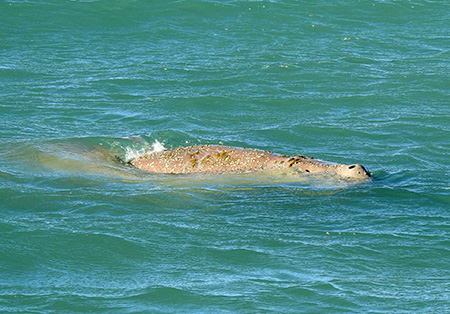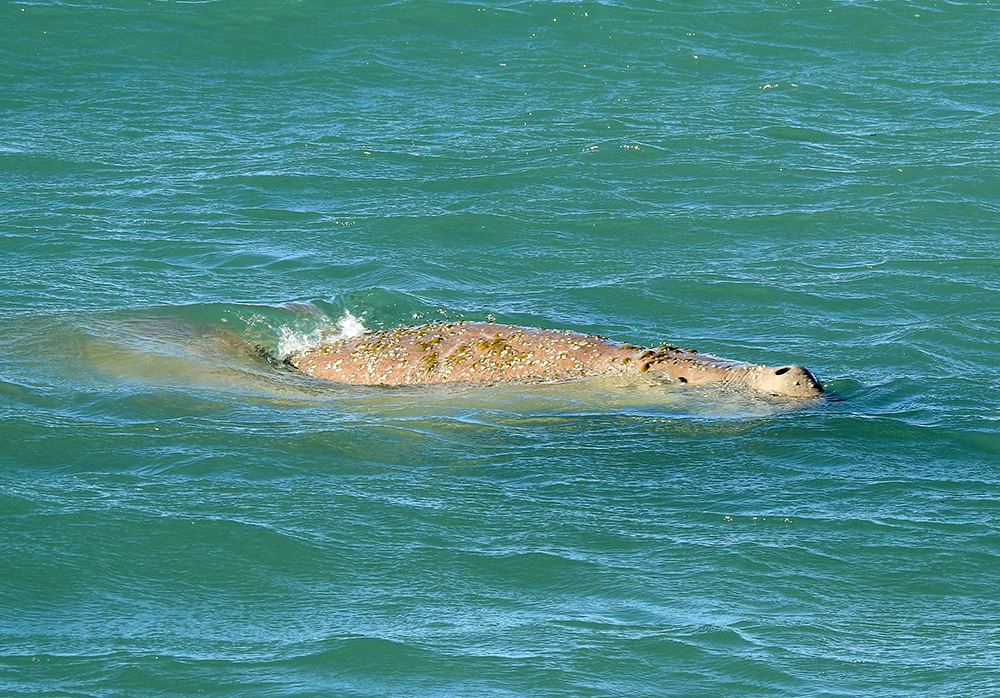Dugongs
Protecting the dugong—the mega-herbivore of the sea
The dugong’s long lifespan and slow breeding rate, combined with marine habitat changes, bycatch fishing and boat strikes make it vulnerable to extinction.

Fast facts
Common name: Dugong
Scientific name: Dugong dugon
Family: Dugongidae
Status: Vulnerable
Habitat: Subtropical and tropical waters in shallow, wide, calm and protected bays
Species overview
The dugong is closely related to the manatees, and both are distantly related to the elephant and not to other marine mammals. It is the only plant-eating mammal that lives its entire life in the ocean.
Dugongs are culturally significant to many coastal First Nation communities.
The dugong’s distribution stretches across the Indo-Pacific region. Within Australia, it is found from Moreton Bay on the Queensland coast across northern Australia to Shark Bay in Western Australia.
Often called sea cows, these shy, slow-moving mammals spend most of their day feeding on a species of seagrass. Seagrass habitats are sensitive to extreme weather events like cyclones and flooding.
Dugong populations globally have been depleted by habitat degradation due to coastal development, water quality changes, boat-strike, hunting and accidental bycatch in fisheries. Those threats, combined with a long lifespan and slow reproductive rate, make the dugong particularly vulnerable to extinction.
Behaviour and ecology
Dugongs are known as cultivation grazers because their feeding promotes the growth of their favoured seagrass species (Halophila ovalis). By uprooting the seagrass, they stimulate nitrogen fixation, aerate the sea floor and increase the amount of organic matter in the area, encouraging seagrass regrowth. Halophila ovalis is a fast-growing seagrass that is high in nitrogen and low in fibre.
An adult dugong will eat about 30kg of seagrass each day. Dugongs have relatively poor eyesight, so they use the sensitive bristles covering the upper lip of their large snouts to find seagrass.
Dugongs mature between 10–17 years old and can live up to 70. A female only reproduces every 3–7 years. After giving birth, she nurses and nurtures her calf for 1–2 years. As mammals, dugong calves suckle milk.

Characteristics
The dugong has:
- a length of about 3m (adult)
- a weight of up to 500kg (adult)
- a body shape like dolphins but more robust
- a large, rounded head with a distinctive downturned snout
- peg-like teeth
- two paddle-like forelimbs (flippers)
- smooth and thick greyish skin
- a fluked tail like a whale or dolphin.
Threats
- Habitat degradation and modification
- Boat strikes
- Accidental bycatch from commercial and recreational fishing activities and shark-control netting.
What’s being done?
- We manage numerous national parks and marine protected areas, including the Great Barrier Reef Coastal Marine Park, Great Sandy Marine Park, and Moreton Bay Marine Park, where we provide extensive habitat protection and regulate potentially harmful activities, minimising their impacts on dugongs.
- We have established several closed areas for gillnet fishing along the east coast, including a gillnet-free zone in the far north of the Great Barrier Reef from Cape Bedford to the tip of Cape York. This zoning protects dugongs and other threatened marine species from the risks of gillnetting in those areas.
- As part of the new zoning plan for the Great Sandy Marine Park, we have increased the proportion of highly-protected zones to conserve the park’s marine life, including seagrass meadows which will help support dugongs. The new zoning plan also includes the removal of commercial large mesh gillnets and ring nets from certain areas, while new and expanded Go Slow areas provide more comprehensive protection for dugongs (and turtles) from the risk of boat strike.
- We conduct aerial surveys every 5 years to monitor the distribution and abundance of dugongs and seagrass along Queensland's coast in conjunction with partners.
- We conduct annual health assessments and biological research in Moreton Bay.
- We undertake drone-based surveys to assess dugong body condition.
- We use e-DNA and genomics approaches to enhance our monitoring and advance research of dugongs and seagrass.
- Alongside other partner agencies and fishers, we are working to reduce bycatch by phasing out gillnets for commercial fishing in the Great Barrier Reef by 2027.
- We partner with First Nations communities on Sea Country and provide them with tools to monitor dugongs and seagrass effectively.
Who is helping?
- James Cook University (JCU)
JCU’s TropWATER aerial and other surveys monitor dugong populations and seagrass habitat, including light availability. - The University of Queensland (UQ)
UQ’s research team has monitored dugong population dynamics in Moreton Bay for 30 years and conducted annual health assessments since 2000. - Science Under Sail Australia (SUSA)
SUSA conducts seagrass surveys in Queensland’s marine parks, involving citizen scientists in this research. - Seaworld
Seaworld supports research on dugong health assessment and the impact of coastal development, including major ports, on dugong populations and seagrass communities.
How you can help
- If you are boating, always ‘Go slow for those below’, especially in shallow or seagrass-rich areas to avoid accidentally injuring dugongs and other marine life with propeller strikes. When dugongs come to the surface to breathe, they can be hard to spot.
- Operate and anchor your boat carefully to avoid damaging seagrass habitats.
- Report dugong sightings, including sick, injured or dead animals, by calling 1300 130 372.
- Make a donation to support Queensland threatened species protection and science and research-based initiatives.
- Find out more about how you can help support threatened species efforts.
More information
- Species profile (Qld, Wildnet)
- Great Barrier Reef gillnet fishing phase out
- Great Sandy Marine Park zoning plan
- National Dugong and Turtle Protection Plan
- Seagrass
- Species profile (Australia, SPRAT)


